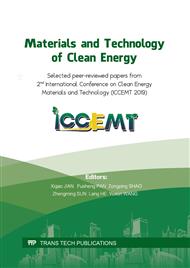[1]
BP Company. BP Statistical Review of World Energy. London, (2019).
Google Scholar
[2]
Jixian Yang, Yingqing He, Xiuyun Zhang, et al. Energy development trend and the coal enterprises`s countermeasures in China under the background of low-carbon economy, China Min. Maga. 19 (2010) 54-57.
Google Scholar
[3]
C. Song. Project planning and practical exploration of science and technology cloud, for clean coal technology, Institute of high energy physics, Chinese Academy of Sciences, Beijing, (2013).
Google Scholar
[4]
Y.N. Zhang, P. Chen, S.Y. Liu, et al. Effects of feedstock characteristics on microwave-assisted pyrolysis—A review. Bioresource Technol. 230 (2017) 143-151.
Google Scholar
[5]
J. Zhou, L. Wu, K. Liang, et al. Status quo of applied microwave technique to pyrolysis process of coal. Mater. Rep. 33 (2019) 191-197.
Google Scholar
[6]
F. Motasemi, M.T. Afzal. A riview on the microwave-assisted pyrolysis technique. Renew. Sustain. Ener. Rev. 28 (2013) 317-330.
Google Scholar
[7]
S. Marland, A. Merchant, N. Rowson. Dieletric properties of coal. Fuel, 80 (2001) 1839-1849.
DOI: 10.1016/s0016-2361(01)00050-3
Google Scholar
[8]
S.Q. Liu, Y.J. Zhang, K.Y. Tuo, et al. Structure, electrical conductivity, and dielectric properties of semi-coke derived from microwave-pyrolyzed low-rank cola. Fuel Process. Technol.178 (2018) 139-147.
DOI: 10.1016/j.fuproc.2018.05.028
Google Scholar
[9]
S.Q. Liu, Y.J. Zhang, C.F. Zhang, et al. Microwave assisted pyrolysis of lignite with microwave absorbers. J. China Coal Soc. 42 (2017) 3280-3285.
Google Scholar
[10]
P. Zhu, Z.P. Yu, J.L. Zhang, et al. Catalytic pyrolysis of Bituminous coal under pyrolysis gas over a Ni/MgO catalyst. Chem. Eng. Technol. 40 (2017) 1605-1610.
DOI: 10.1002/ceat.201700163
Google Scholar
[11]
X.M. Gong, Z. Wang, S.G. Li, et al. Coal pyrolysis in a laboratory-scale two-stage reactor: Catalytic upgrading of pyrolytic vapors. Chem. Eng. Technol. 37 (2014) 2135-2142.
DOI: 10.1002/ceat.201300748
Google Scholar
[12]
P.M. Mirzai, M.Ravindran, W.R. McWhinnie, et al. The use of microwave heating for the pyrolysis of coal via inorganic receptors of microwave energy.. Fuel, 71(1992) 716-717.
DOI: 10.1016/0016-2361(92)90180-v
Google Scholar
[13]
P.M. Mirzai, M. Ravindran, W.R. McWhinnie, et al. Rapid microwave pyrolysis of coal: Methodology and examination of the residual and volatile phases. Fuel, 74 (1995) 20-27.
DOI: 10.1016/0016-2361(94)p4325-v
Google Scholar
[14]
B.R. Reddy, R. Vinu. Microwave assisted pyrolysis of Indian and Indonesian coals and product characterization. Fuel Process. Techonl. 154 (2016) 96-103.
DOI: 10.1016/j.fuproc.2016.08.016
Google Scholar
[15]
Z. Li, X.C. Zhao, B.B. Miao, et al. Preparation of supported Fe2O3/γ-Al2O3 catalyst and its performance in microwave pyrolysis of coal. J. Mat. Sci. Eng. 32 (2014) 826-829.
Google Scholar
[16]
J.H. Zhao, X.L. Cheng, L.C. Wang, et al. Hydrogenation of tar residue derived from the synthesis of rubber vulcanization accelerator 2-mercaptobenzothiazle. Asia-pac. J. Chem. Eng. 12 (2017) 400-405.
DOI: 10.1002/apj.2082
Google Scholar
[17]
F.L. Pua, C.H. Chia, S. Zakaria, et al. Nano transition metal sulfide catalyst for solvolysis liquefaction of soda lignin. Sains Malays. 40 (2011) 221-226.
Google Scholar
[18]
J. Zhou, L. Wu, K. Liang, et al. The Synergistic Mechanism on microwave and MoS2 in coal pyrolysis. J. Anal. Appl. Pyrol. 134 (2018) 580-589.
Google Scholar
[19]
J. Zhou, L. Wu, J.J. Zhou, et al. Products optimization by FeS2 catalyst for low-rank coal microwave pyrolysis. Fuel, 255 (2019) 115759.
DOI: 10.1016/j.fuel.2019.115759
Google Scholar
[20]
J. Zhou, Z. Yang, X.F. Liu, et al. Study on microwave co-pyrolysis of low rank coal and circulating coal gas. Spectrosc. Spect. Anal. 36 (2016) 459-465.
Google Scholar
[21]
J. Zhou, L. Wu, K. Liang, et al. Hydrothermal preparation of petal-like MoS2 and its TG-FTIR analysis: Submitted to Journal of Applied Spectroscopy (2019), accepted.
Google Scholar
[22]
J. Zhou, X.z. Lan, X.c. Zhao, et al. An experimental apparatus of coal-gas microwave co-pyrolysis. Chinese patent 201220436061.9 (2012).
Google Scholar
[23]
Q.R. Liu, H. He, H.P. Li, et al. Characteristics and kinetics of coal char steam gasification under microwave heating. Fuel, 256 (2019) 115899.
DOI: 10.1016/j.fuel.2019.115899
Google Scholar
[24]
W.L. Wang, Z. Liu, J. Sun, et al. Experimental study on the heating effects of microwave discharge caused by metals. AIChE J. 58 (2012) 3852-3857.
DOI: 10.1002/aic.13766
Google Scholar
[25]
Q.D. Wang, G.H. Wang, B. Chen, et al. Permittivity-based microwave absorption characteristics of Dongsheng lignite during pyrolysis. Energ. Technol. 4 (2016) 641-646.
DOI: 10.1002/ente.201500437
Google Scholar
[26]
Z.W. Peng, J.Y. Hwang, B.G. Kim, et al. Microwave absorption capability of high volatile bituminous coal during pyrolysis. Energ. Fuel. 26 (2012) 5146-5151.
DOI: 10.1021/ef300914f
Google Scholar
[27]
M. Alaei, M. Bazmi, A. Rashidi, et al. Heavy crude oil upgrading using homogenous nanocatalyst. J. Petrol. Sci. Eng. 158 (2017) 47-55.
DOI: 10.1016/j.petrol.2017.08.031
Google Scholar
[28]
Z.F. Chang, P.G. Duan, Y.P. Xu. Catalytic hydropyrolysis of microalgae: Influence of operating variables on the formation and composition of bio-oil. Bioresource Technol. 184 (2015) 349-354.
DOI: 10.1016/j.biortech.2014.08.014
Google Scholar
[29]
P. Liu, J.W. Le, L.L. Wang, et al. Relevance of carbon structure to formation of tar and liquid alkane during coal pyrolysis. Appl. Energ. 183 (2016) 470-477.
DOI: 10.1016/j.apenergy.2016.08.166
Google Scholar
[30]
X.C. Lin, M. Luo, S.Y. Li, et al. The evolutionary route of coal matrix during integrated cascade pyrolysis of a typical low-rank coal. Appl. Energ. 199 (2017) 335-346.
DOI: 10.1016/j.apenergy.2017.05.040
Google Scholar
[31]
Q.Z. Li, B.Q. Lin, C.S. Zhao, et al. Chemical structure analysis of coal char surface based on Fourier-Transform Infrared Spectrometer. Proc. CSEE, 31 (2011) 46-52.
Google Scholar
[32]
H.I. Petersen, P. Rosenberg, H.P. Nytoft. Oxygen groups in coals and alginate-rich kerogen revisted. Int. J. Coal Geol. 74 (2008) 93-113.
DOI: 10.1016/j.coal.2007.11.007
Google Scholar


